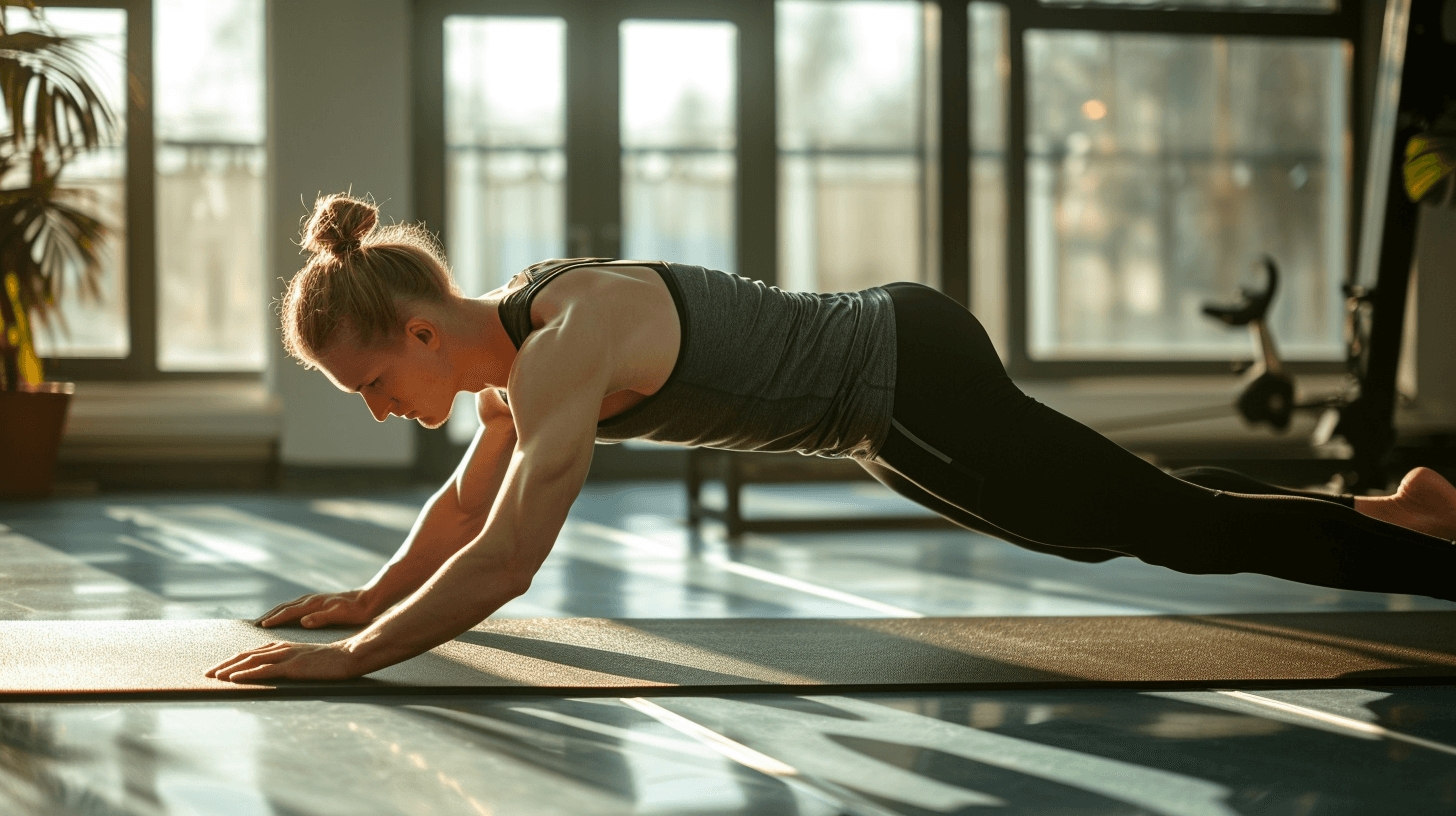Workout
Calisthenics Workout Plan, Guide and Tips for Beginners
Discover a beginner-friendly calisthenics workout plan. Learn exercises, tips, and routines to build strength and endurance using your body weight.
Mar 27, 2025



Are you new to fitness and looking for a workout plan that doesn’t require a gym membership or expensive equipment? Calisthenics might be the perfect solution for you. This type of workout uses your body weight to build strength, flexibility, and endurance. It’s an excellent choice for beginners because it focuses on mastering fundamental movements that are the foundation of any fitness routine. Plus, calisthenics can be done anywhere, making it ideal for busy professionals and fitness enthusiasts alike. In this guide, we’ll walk you through a beginner-friendly calisthenics workout plan, offer tips to stay motivated, and show you how to progress as you get stronger.
Are you new to fitness and looking for a workout plan that doesn’t require a gym membership or expensive equipment? Calisthenics might be the perfect solution for you. This type of workout uses your body weight to build strength, flexibility, and endurance. It’s an excellent choice for beginners because it focuses on mastering fundamental movements that are the foundation of any fitness routine. Plus, calisthenics can be done anywhere, making it ideal for busy professionals and fitness enthusiasts alike. In this guide, we’ll walk you through a beginner-friendly calisthenics workout plan, offer tips to stay motivated, and show you how to progress as you get stronger.
What is Calisthenics?

Calisthenics is a form of exercise that utilizes your own body weight for resistance. Common exercises include push-ups, pull-ups, squats, and planks. This type of training is beneficial because it improves functional strength, mobility, and coordination without the need for weights or machines. Calisthenics workouts can be adapted to any fitness level, making them perfect for beginners who are just starting out.
Benefits of Calisthenics

Accessibility: No gym required. You can perform calisthenics exercises anywhere.
Versatility: Exercises can be modified to suit all fitness levels.
Functional Strength: Improves your ability to perform everyday activities.
Cost-Effective: No need for expensive equipment or memberships.
Low Risk of Injury: Bodyweight exercises tend to be safer compared to lifting heavy weights.
Starting Your Calisthenics Journey
Before you begin, it’s important to set realistic goals and understand your current fitness level. Start with a warm-up to prepare your muscles and joints. This can include light cardio like jogging in place or jumping jacks for 5-10 minutes.
Essential Calisthenics Exercises for Beginners
Push-Ups: A foundational upper body exercise that strengthens the chest, shoulders, and triceps.
How to Perform: Start in a plank position with your hands shoulder-width apart. Lower your body until your chest nearly touches the ground, then push back up to the starting position.
Modification: Perform on knees if a full push-up is too challenging.
Squats: Targets the lower body, including the quads, hamstrings, and glutes.
How to Perform: Stand with feet shoulder-width apart. Lower your body by bending your knees and pushing your hips back, then return to the starting position.
Modification: Use a chair to guide your movement if needed.
Planks: Strengthens the core, shoulders, and back.
How to Perform: Start in a forearm plank position. Keep your body in a straight line from head to heels. Hold this position for as long as possible.
Modification: Drop your knees to the ground to reduce intensity.
Lunges: Engages the legs and glutes while improving balance.
How to Perform: Step forward with one leg and lower your hips until both knees are bent at a 90-degree angle. Return to the starting position and repeat on the other side
Modification: Hold onto a wall or chair for balance.
Pull-Ups: Strengthens the back, shoulders, and arms.
How to Perform: Hang from a pull-up bar with an overhand grip. Pull your body up until your chin is above the bar, then lower back down.
Modification: Use a resistance band for assistance.
Creating a Beginner Calisthenics Workout Plan
Here's a calisthenics workout plan perfect for beginners:
Week 1-2: Building the Foundation
Monday: Push-Ups - 3 sets of 8-10 reps, Squats - 3 sets of 10-12 reps, Planks - 3 sets of 20-30 seconds
Wednesday: Lunges - 3 sets of 10 reps each leg, Assisted Pull-Ups - 3 sets of 5-8 reps, Planks - 3 sets of 20-30 seconds
Friday: Push-Ups - 3 sets of 8-10 reps, Squats - 3 sets of 10-12 reps, Planks - 3 sets of 20-30 seconds
Week 3-4: Increasing Intensity
Monday: Push-Ups - 4 sets of 10-12 reps, Squats - 4 sets of 12-15 reps, Planks - 4 sets of 30-40 seconds
Wednesday: Lunges - 4 sets of 12 reps each leg, Assisted Pull-Ups - 4 sets of 6-10 reps, Planks - 4 sets of 30-40 seconds
Friday: Push-Ups - 4 sets of 10-12 reps, Squats - 4 sets of 12-15 reps, Planks - 4 sets of 30-40 seconds
Tips for Staying Motivated
Set Clear Goals: Define what you want to achieve with your calisthenics routine.
Track Progress: Keep a workout journal to monitor improvements.
Stay Consistent: Make exercise a regular part of your routine.
Find a Workout Buddy: Exercising with a friend can keep you motivated.
Mix It Up: Vary your exercises to keep things interesting and challenge your body.
Nutrition Tips for Beginners

A proper diet is crucial for any fitness program. Focus on consuming a balanced diet rich in protein, healthy fats, and complex carbohydrates. Stay hydrated and consider consulting with a nutritionist for personalized advice.
What is Calisthenics?

Calisthenics is a form of exercise that utilizes your own body weight for resistance. Common exercises include push-ups, pull-ups, squats, and planks. This type of training is beneficial because it improves functional strength, mobility, and coordination without the need for weights or machines. Calisthenics workouts can be adapted to any fitness level, making them perfect for beginners who are just starting out.
Benefits of Calisthenics

Accessibility: No gym required. You can perform calisthenics exercises anywhere.
Versatility: Exercises can be modified to suit all fitness levels.
Functional Strength: Improves your ability to perform everyday activities.
Cost-Effective: No need for expensive equipment or memberships.
Low Risk of Injury: Bodyweight exercises tend to be safer compared to lifting heavy weights.
Starting Your Calisthenics Journey
Before you begin, it’s important to set realistic goals and understand your current fitness level. Start with a warm-up to prepare your muscles and joints. This can include light cardio like jogging in place or jumping jacks for 5-10 minutes.
Essential Calisthenics Exercises for Beginners
Push-Ups: A foundational upper body exercise that strengthens the chest, shoulders, and triceps.
How to Perform: Start in a plank position with your hands shoulder-width apart. Lower your body until your chest nearly touches the ground, then push back up to the starting position.
Modification: Perform on knees if a full push-up is too challenging.
Squats: Targets the lower body, including the quads, hamstrings, and glutes.
How to Perform: Stand with feet shoulder-width apart. Lower your body by bending your knees and pushing your hips back, then return to the starting position.
Modification: Use a chair to guide your movement if needed.
Planks: Strengthens the core, shoulders, and back.
How to Perform: Start in a forearm plank position. Keep your body in a straight line from head to heels. Hold this position for as long as possible.
Modification: Drop your knees to the ground to reduce intensity.
Lunges: Engages the legs and glutes while improving balance.
How to Perform: Step forward with one leg and lower your hips until both knees are bent at a 90-degree angle. Return to the starting position and repeat on the other side
Modification: Hold onto a wall or chair for balance.
Pull-Ups: Strengthens the back, shoulders, and arms.
How to Perform: Hang from a pull-up bar with an overhand grip. Pull your body up until your chin is above the bar, then lower back down.
Modification: Use a resistance band for assistance.
Creating a Beginner Calisthenics Workout Plan
Here's a calisthenics workout plan perfect for beginners:
Week 1-2: Building the Foundation
Monday: Push-Ups - 3 sets of 8-10 reps, Squats - 3 sets of 10-12 reps, Planks - 3 sets of 20-30 seconds
Wednesday: Lunges - 3 sets of 10 reps each leg, Assisted Pull-Ups - 3 sets of 5-8 reps, Planks - 3 sets of 20-30 seconds
Friday: Push-Ups - 3 sets of 8-10 reps, Squats - 3 sets of 10-12 reps, Planks - 3 sets of 20-30 seconds
Week 3-4: Increasing Intensity
Monday: Push-Ups - 4 sets of 10-12 reps, Squats - 4 sets of 12-15 reps, Planks - 4 sets of 30-40 seconds
Wednesday: Lunges - 4 sets of 12 reps each leg, Assisted Pull-Ups - 4 sets of 6-10 reps, Planks - 4 sets of 30-40 seconds
Friday: Push-Ups - 4 sets of 10-12 reps, Squats - 4 sets of 12-15 reps, Planks - 4 sets of 30-40 seconds
Tips for Staying Motivated
Set Clear Goals: Define what you want to achieve with your calisthenics routine.
Track Progress: Keep a workout journal to monitor improvements.
Stay Consistent: Make exercise a regular part of your routine.
Find a Workout Buddy: Exercising with a friend can keep you motivated.
Mix It Up: Vary your exercises to keep things interesting and challenge your body.
Nutrition Tips for Beginners

A proper diet is crucial for any fitness program. Focus on consuming a balanced diet rich in protein, healthy fats, and complex carbohydrates. Stay hydrated and consider consulting with a nutritionist for personalized advice.

Your all-in-one fitness plan is just one click away
Try it free for 7 days. Cancel anytime.

Your all-in-one fitness plan is just one click away
Try it free for 7 days. Cancel anytime.

Your all-in-one fitness plan is just one click away
Try it free for 7 days.
Cancel anytime.
Conclusion
Starting a calisthenics workout plan as a beginner is an excellent way to build strength, flexibility, and overall fitness without the need for expensive equipment or a gym membership. By focusing on fundamental exercises like push-ups, squats, planks, lunges, and pull-ups, you can create a solid foundation for your fitness journey. Remember to stay consistent, set clear goals, and track your progress. With dedication and the right plan, you’ll see significant improvements in your strength and endurance.
At Fit Senpai, we’re dedicated to helping you achieve your health and fitness goals. Explore our customized workout and meal plans tailored to your unique needs. Join our community today and start your journey towards a healthier, fitter you!
Conclusion
Starting a calisthenics workout plan as a beginner is an excellent way to build strength, flexibility, and overall fitness without the need for expensive equipment or a gym membership. By focusing on fundamental exercises like push-ups, squats, planks, lunges, and pull-ups, you can create a solid foundation for your fitness journey. Remember to stay consistent, set clear goals, and track your progress. With dedication and the right plan, you’ll see significant improvements in your strength and endurance.
At Fit Senpai, we’re dedicated to helping you achieve your health and fitness goals. Explore our customized workout and meal plans tailored to your unique needs. Join our community today and start your journey towards a healthier, fitter you!
Conclusion
Starting a calisthenics workout plan as a beginner is an excellent way to build strength, flexibility, and overall fitness without the need for expensive equipment or a gym membership. By focusing on fundamental exercises like push-ups, squats, planks, lunges, and pull-ups, you can create a solid foundation for your fitness journey. Remember to stay consistent, set clear goals, and track your progress. With dedication and the right plan, you’ll see significant improvements in your strength and endurance.
At Fit Senpai, we’re dedicated to helping you achieve your health and fitness goals. Explore our customized workout and meal plans tailored to your unique needs. Join our community today and start your journey towards a healthier, fitter you!
FAQ
What is calisthenics?
Calisthenics is a form of exercise that uses your body weight for resistance to build strength, flexibility, and endurance.
Can beginners do calisthenics?
Yes, calisthenics is ideal for beginners because exercises can be easily modified to match any fitness level.
Do I need any calisthenics equipment?
No, most calisthenics exercises can be performed without any equipment, though a pull-up bar can be helpful.
How often should I do calisthenics as a beginner?
Start with three times a week, allowing rest days in between for recovery.
How long should my workouts be?
Begin with 20-30 minute sessions and gradually increase as your endurance improves.
Can I build muscle with calisthenics?
Yes, consistent calisthenics training can build muscle and improve overall strength.
What should I eat to support my calisthenics training?
Focus on a balanced diet with plenty of protein, healthy fats, and complex carbohydrates.
How do I stay motivated to stick with my workout plan?
Set clear goals, track your progress, and consider working out with a friend to stay motivated.
Is it normal to feel sore after calisthenics workouts?
Yes, muscle soreness is common, especially when starting a new workout routine. Ensure you get enough rest and recovery.
Where can I find more resources on calisthenics?
Check out Fit Senpai’s blog for more tips, workout plans, and nutrition advice to support your fitness journey.
FAQ
What is calisthenics?
Calisthenics is a form of exercise that uses your body weight for resistance to build strength, flexibility, and endurance.
Can beginners do calisthenics?
Yes, calisthenics is ideal for beginners because exercises can be easily modified to match any fitness level.
Do I need any calisthenics equipment?
No, most calisthenics exercises can be performed without any equipment, though a pull-up bar can be helpful.
How often should I do calisthenics as a beginner?
Start with three times a week, allowing rest days in between for recovery.
How long should my workouts be?
Begin with 20-30 minute sessions and gradually increase as your endurance improves.
Can I build muscle with calisthenics?
Yes, consistent calisthenics training can build muscle and improve overall strength.
What should I eat to support my calisthenics training?
Focus on a balanced diet with plenty of protein, healthy fats, and complex carbohydrates.
How do I stay motivated to stick with my workout plan?
Set clear goals, track your progress, and consider working out with a friend to stay motivated.
Is it normal to feel sore after calisthenics workouts?
Yes, muscle soreness is common, especially when starting a new workout routine. Ensure you get enough rest and recovery.
Where can I find more resources on calisthenics?
Check out Fit Senpai’s blog for more tips, workout plans, and nutrition advice to support your fitness journey.
FAQ
What is calisthenics?
Calisthenics is a form of exercise that uses your body weight for resistance to build strength, flexibility, and endurance.
Can beginners do calisthenics?
Yes, calisthenics is ideal for beginners because exercises can be easily modified to match any fitness level.
Do I need any calisthenics equipment?
No, most calisthenics exercises can be performed without any equipment, though a pull-up bar can be helpful.
How often should I do calisthenics as a beginner?
Start with three times a week, allowing rest days in between for recovery.
How long should my workouts be?
Begin with 20-30 minute sessions and gradually increase as your endurance improves.
Can I build muscle with calisthenics?
Yes, consistent calisthenics training can build muscle and improve overall strength.
What should I eat to support my calisthenics training?
Focus on a balanced diet with plenty of protein, healthy fats, and complex carbohydrates.
How do I stay motivated to stick with my workout plan?
Set clear goals, track your progress, and consider working out with a friend to stay motivated.
Is it normal to feel sore after calisthenics workouts?
Yes, muscle soreness is common, especially when starting a new workout routine. Ensure you get enough rest and recovery.
Where can I find more resources on calisthenics?
Check out Fit Senpai’s blog for more tips, workout plans, and nutrition advice to support your fitness journey.
You may also want to read this:
You may also want to read this:



Push Pull Legs Workout – A Balanced Workout Plan That Works
Build muscle with the Push-Pull-Legs (PPL) workout split. A balanced routine for strength and recovery that’s popular among gym-goers for results.



Achieve Muscle Balance with an Upper and Lower Split Program
Maximize gym sessions with an upper-lower split for strength and balance. Get a custom workout plan to achieve your fitness goals!



Get Maximum Gains with the Ultimate 5-Day Split Workout Plan
Build muscle fast with this 5-day split workout plan. Learn key exercises, progressive overload tips, and recovery strategies to maximize gains
Your all-in-one fitness plan is just one click away
Try it free for 7 days. Cancel anytime.
Your all-in-one fitness plan is just one click away
Try it free for 7 days. Cancel anytime.
Your all-in-one fitness plan is just one click away
Try it free for 7 days. Cancel anytime.




